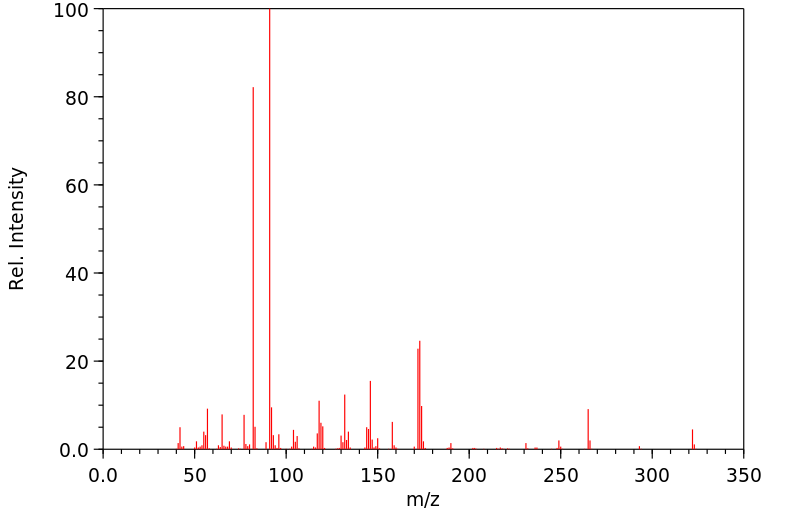N-(1-苄基哌啶-4-基)-N-苯基丙酰胺 | 1474-02-8
中文名称
N-(1-苄基哌啶-4-基)-N-苯基丙酰胺
中文别名
芬太尼USP杂质F
英文名称
N-(1-benzyl-4-piperidinyl)-N-phenylpropionamide
英文别名
N-(1-benzyl-4-piperidinyl)propionanilide;benzylfentanyl;N-(1-benzylpiperidin-4-yl)-N-phenylpropionamide;N-(1-benzylpiperidin-4-yl)-N-phenylpropanamide
CAS
1474-02-8
化学式
C21H26N2O
mdl
——
分子量
322.45
InChiKey
POQDXIFVWVZVML-UHFFFAOYSA-N
BEILSTEIN
——
EINECS
——
-
物化性质
-
计算性质
-
ADMET
-
安全信息
-
SDS
-
制备方法与用途
-
上下游信息
-
文献信息
-
表征谱图
-
同类化合物
-
相关功能分类
-
相关结构分类
计算性质
-
辛醇/水分配系数(LogP):3.6
-
重原子数:24
-
可旋转键数:5
-
环数:3.0
-
sp3杂化的碳原子比例:0.38
-
拓扑面积:23.6
-
氢给体数:0
-
氢受体数:2
上下游信息
-
上游原料
中文名称 英文名称 CAS号 化学式 分子量 N-苯基-N-(4-哌啶)丙胺 混合盐酸 Norfentanyl 1609-66-1 C14H20N2O 232.326 4-苯胺-1-苯甲基哌啶 1-benzyl-N-phenylpiperidin-4-amine 1155-56-2 C18H22N2 266.386 -
下游产品
中文名称 英文名称 CAS号 化学式 分子量 芬太尼 N-phenyl-N-[1-(2-phenylethyl)-4-piperidinyl]propanamide 437-38-7 C22H28N2O 336.477 —— N-(1-propyl-4-piperidinyl)propionanilide 1060694-93-0 C17H26N2O 274.406 —— N-<1-(3-Phenylpropyl)-4-piperidyl>-N-phenylpropanamide 59708-54-2 C23H30N2O 350.504 N-苯基-N-(4-哌啶)丙胺 混合盐酸 Norfentanyl 1609-66-1 C14H20N2O 232.326 —— N-{1-[2-(2,6-dimethylphenyl)ethyl]-4-piperidinyl}-N-phenylpropionamide —— C24H32N2O 364.531 —— 1-chlorocarbonyl-4-(N-propionylanilino)piperidine —— C15H19ClN2O2 294.781 N-[1-(2-羟基-2-苯基-乙基)-哌啶-4-基]-n-苯基-丙酰胺 N-<1-(2-Hydroxy-2-phenylethyl)-4-piperidyl>-N-phenylpropanamide 78995-10-5 C22H28N2O2 352.477 —— N-{1-[2-(2,4,6-trimethylphenyl)ethyl]-4-piperidinyl}-N-phenylpropionamide —— C25H34N2O 378.558 —— N-(1-(3-phenoxypropyl)-4-piperidinyl)propionanilide 1417202-11-9 C23H30N2O2 366.503 —— N-{1-[2-(2,6-dimethyl-4-hydroxyphenyl)ethyl]-4-piperidinyl}-N-phenylpropionamide —— C24H32N2O2 380.53 —— N-(1-(2-phenoxyethyl)-4-piperidinyl)propionanilide 59825-55-7 C22H28N2O2 352.477 —— (S)-N-(1-(2-amino-3-phenylpropanoyl)piperidin-4-yl)-N-phenylpropionamide 937738-85-7 C23H29N3O2 379.502 alpha-甲硫基芬太尼 N-<1-<1-Methyl-2-(2-thienyl)ethyl>-4-piperidyl>-N-phenylpropanamide 103963-66-2 C21H28N2OS 356.532 —— N-{1-[2-(2,6-dimethyl-4-methoxyphenyl)ethyl]-4-piperidinyl}-N-phenylpropionamide —— C25H34N2O2 394.557 - 1
- 2
反应信息
-
作为反应物:描述:N-(1-苄基哌啶-4-基)-N-苯基丙酰胺 在 palladium 10% on activated carbon 、 四丁基溴化铵 、 氢气 、 potassium carbonate 作用下, 以 甲醇 、 溶剂黄146 、 乙腈 为溶剂, 生成 芬太尼参考文献:名称:N-(1-苯乙基-4-哌啶基)丙酰苯胺(芬太尼)及其1-取代类似物在瑞士白化病小鼠中的合成及比较生物功效摘要:芬太尼[ N-(1-苯乙基-4-哌啶基)丙酰苯胺]是一种流行的麻醉镇痛剂,在世界范围内都在临床上使用。然而,由于剂量过量和狭窄的治疗指数,芬太尼及其几种类似物已在人类中引起滥用和死亡。本研究报告了芬太尼及其四个类似物,即N-(1-丙基-4-哌啶基)丙酰苯胺(1),N-(1-(2-苯氧基乙基)-4-哌啶基)的合成和比较生物功效。丙酰苯胺(2),N-(1-(3-(苯氧丙基)-4-哌啶基)丙酰苯胺(3)和N-(1-(2-氰基乙基)-4-哌啶基)丙酰苯胺(4),其中芬太尼的苯乙基链被不同的官能团取代,即烷基,醚基和腈基。通过三种不同的途径确定化合物的中值致死剂量(LD 50),发现所有类似物比芬太尼更安全。通过对中枢神经系统,周围神经系统和自主神经系统自发活动的观察评估,发现所有类似物均与芬太尼相似。此外,所有类似物的神经毒性作用均被盐酸纳洛酮(阿片类药物拮抗剂)逆转,证实它们的作用是通过阿片样物DOI:10.1007/s00044-012-0390-6
-
作为产物:描述:N-(1-Benzyl-4-piperidyl)-N-phenylpropanamide Hydrochloride 在 sodium hydroxide 作用下, 以 水 为溶剂, 以90%的产率得到N-(1-苄基哌啶-4-基)-N-苯基丙酰胺参考文献:名称:N-(1-苯乙基-4-哌啶基)丙酰苯胺(芬太尼)及其1-取代类似物在瑞士白化病小鼠中的合成及比较生物功效摘要:芬太尼[ N-(1-苯乙基-4-哌啶基)丙酰苯胺]是一种流行的麻醉镇痛剂,在世界范围内都在临床上使用。然而,由于剂量过量和狭窄的治疗指数,芬太尼及其几种类似物已在人类中引起滥用和死亡。本研究报告了芬太尼及其四个类似物,即N-(1-丙基-4-哌啶基)丙酰苯胺(1),N-(1-(2-苯氧基乙基)-4-哌啶基)的合成和比较生物功效。丙酰苯胺(2),N-(1-(3-(苯氧丙基)-4-哌啶基)丙酰苯胺(3)和N-(1-(2-氰基乙基)-4-哌啶基)丙酰苯胺(4),其中芬太尼的苯乙基链被不同的官能团取代,即烷基,醚基和腈基。通过三种不同的途径确定化合物的中值致死剂量(LD 50),发现所有类似物比芬太尼更安全。通过对中枢神经系统,周围神经系统和自主神经系统自发活动的观察评估,发现所有类似物均与芬太尼相似。此外,所有类似物的神经毒性作用均被盐酸纳洛酮(阿片类药物拮抗剂)逆转,证实它们的作用是通过阿片样物DOI:10.1007/s00044-012-0390-6
文献信息
-
Metabolism of Fentanyl and Acetylfentanyl in Human-Induced Pluripotent Stem Cell-Derived Hepatocytes作者:Tatsuyuki Kanamori、Yuko Togawa Iwata、Hiroki Segawa、Tadashi Yamamuro、Kenji Kuwayama、Kenji Tsujikawa、Hiroyuki InoueDOI:10.1248/bpb.b17-00709日期:——To evaluate the capability of human-induced pluripotent stem cell-derived hepatocytes (h-iPS-HEP) in drug metabolism, the profiles of the metabolites of fentanyl, a powerful synthetic opioid, and acetylfentanyl, an N-acetyl analog of fentanyl, in the cells were determined and analyzed. Commercially available h-iPS-HEP were incubated with fentanyl or acetylfentanyl for 24 or 48 h. After enzymatic hydrolysis, the medium was deproteinized with acetonitrile, then analyzed by LC/MS. Desphenethylated metabolites and some hydroxylated metabolites, including 4′-hydroxy-fentanyl and β-hydroxy-fentanyl, were detected as metabolites of fentanyl and acetylfentanyl in the medium. The main metabolite of fentanyl with h-iPS-HEP was the desphenethylated metabolite, which was in agreement with in vivo results. These results suggest that h-iPS-HEP may be useful as a tool for investigating drug metabolism.
-
Synthesis and Biological Evaluation of Fentanyl Analogues Modified at Phenyl Groups with Alkyls作者:Yajuan Qin、Luofan Ni、Jiawei Shi、Zhiying Zhu、Saijian Shi、Ai-leen Lam、Julia Magiera、Sunderajhan Sekar、Andy Kuo、Maree T. Smith、Tingyou LiDOI:10.1021/acschemneuro.8b00363日期:2019.1.16Compounds 10 and 11 are potent MOP receptor agonists with weak δ-opioid (DOP) receptor antagonist activity and moderate KOP receptor antagonist activity as well as weak β-arrestin2 recruitment activity at the MOP receptor. These compounds are promising leads for discovery of potent opioid analgesics with reduced side effects relative to clinically available strong opioid analgesics.
-
Carbon-13 nuclear magnetic resonance spectra of fentanyl analogs作者:G. A. Brine、K. G. Boldt、P.-T. Huang、D. K. Sawyer、F. I. CarrollDOI:10.1002/jhet.5570260329日期:1989.5Natural abundance carbon-13 chemical shifts are reported for the hydrochloride salts of fentanyl (1a) and fifteen analogs. The signals are assigned on the basis of chemical shift theory, SFORD multiplicities, signal intensities, comparisons with model compounds, and thiophene carbon-proton coupling constants. In addition to its forensic value, the data suggest that the solution conformations of the
-
Use of Triphosgene for Direct Preparation of Carbamoyl Chlorides from Tertiary Benzylamines
-
Preparation of Fentanyl Labeled with Carbon-14作者:M. Nami、M. Dabiri、G. Shirvani、M. A. Ahmadi Faghih、M. JavaheriDOI:10.1134/s1066362218010071日期:2018.1A convenient synthetic pathway for 14C labeling of fentanyl [N-(1-phenethyl-4-piperidinyl)- propionanilide], a widely used narcotic analgesic agent, with good radiochemical yield was developed.
表征谱图
-
氢谱1HNMR
-
质谱MS
-
碳谱13CNMR
-
红外IR
-
拉曼Raman
-
峰位数据
-
峰位匹配
-
表征信息
同类化合物
(R)-3-甲基哌啶盐酸盐;
(R)-2-苄基哌啶-1-羧酸叔丁酯
((3S,4R)-3-氨基-4-羟基哌啶-1-基)(2-(1-(环丙基甲基)-1H-吲哚-2-基)-7-甲氧基-1-甲基-1H-苯并[d]咪唑-5-基)甲酮盐酸盐
高氯酸哌啶
高托品酮肟
马来酸帕罗西汀
颜料红48:4
顺式3-氟哌啶-4-醇盐酸盐
顺式2,6-二甲基哌啶-4-酮
顺式1-苄基-4-甲基-3-甲氨基-哌啶
顺式-叔丁基4-羟基-3-甲基哌啶-1-羧酸酯
顺式-6-甲基-哌啶-1,3-二甲酸1-叔丁酯
顺式-5-(三氟甲基)哌啶-3-羧酸甲酯盐酸盐
顺式-4-叔丁基-2-甲基哌啶
顺式-4-Boc-氨基哌啶-3-甲酸甲酯
顺式-4-(氮杂环丁烷-1-基)-3-氟哌
顺式-3-顺式-4-氨基哌啶
顺式-3-甲氧基-4-氨基哌啶
顺式-3-BOC-3,7-二氮杂双环[4.2.0]辛烷
顺式-3-(1-吡咯烷基)环丁腈
顺式-3,5-哌啶二羧酸
顺式-3,4-二溴-3-甲基吡咯烷盐酸盐
顺式-2,6-二甲基-4-氧代哌啶-1-羧酸叔丁基酯
顺式-1-叔丁氧羰基-4-甲基氨基-3-羟基哌啶
顺式-1-boc-3,4-二氨基哌啶
顺式-1-(4-叔丁基环己基)-4-苯基-4-哌啶腈
顺式-1,3-二甲基-4-乙炔基-6-苯基-3,4-哌啶二醇
顺-4-(4-氟苯基)-1-(4-异丙基环己基)-4-哌啶羧酸
顺-4-(2-氟苯基)-1-(4-异丙基环己基)-4-哌啶羧酸
顺-3-氨基-4-氟哌啶-1-羧酸叔丁酯
顺-1-苄基-4-甲基哌啶-3-氨基酸甲酯盐酸盐
非莫西汀
雷芬那辛
雷拉地尔
阿维巴坦中间体4
阿格列汀杂质
阿尼利定盐酸盐 CII
阿尼利定
阿塔匹酮
阿哌沙班杂质BMS-591455
阿哌沙班杂质87
阿哌沙班杂质52
阿哌沙班杂质51
阿哌沙班杂质5
阿哌沙班杂质
阿哌沙班杂质
阿哌沙班-d3
阿哌沙班
阻聚剂701
间氨基谷氨酰胺







